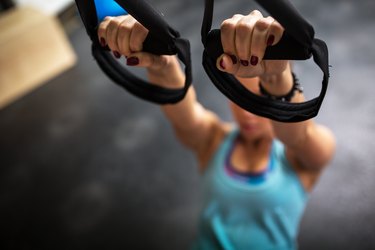
Muscle imbalances can have a negative impact on your appearance, cause poor posture and even increase the risk of injury. A physiotherapist from the mid-20th century, Dr. Vladimir Janda discovered both the upper- and lower-crossed syndromes. The underlying belief of these syndromes — or muscle imbalances — is that tightness in one area of the body leads to weakness in another area.
The upper-crossed syndrome is a muscle imbalance in which the upper back is weak and the chest is too tight, pulling the shoulders and head forward. The lower-crossed syndrome occurs because the lower back muscles are too tight and the abdominals are too weak.
Video of the Day
Video of the Day
Read more: Back Alignment Stretches
1. Lower-Crossed Syndrome
To correct the imbalance between the lower back muscles and the abdominals you focus on exercises that isolate and strengthen the abs. Perform each exercise 10 times, working up to three sets in a row.
Move 1: Reverse Crunch
This exercise targets the abdominal obliques, the muscles on the side of your trunk, which pull in the opposite direction of your lower back muscles, negating some of their influence when they are tight.
HOW TO DO IT: Lie on your back with a heavy weight, like a kettlebell, on the ground above your head. Reach overhead with both arms and hold the kettlebell for stability. Lift your legs in the air with your hips and knees bent to 90 degrees. Press your lower back down into the ground as you roll your hips up off of the ground and back towards your head. Move slowly and with control.
Move 2: Single-Leg Sit-Up
Work the front of your abs, the rectus abdominis, with this sit-up variation.
HOW TO DO IT: Lie on your back with your arms straight up towards the ceiling. One leg should be bent with your foot planted on the ground and the other leg should be straight and flat on the ground. Sit-up to your bent leg while keeping your arms pointed up towards the ceiling. Repeat on the opposite side.
Read more: Dynamic Back Stretches
2. Upper Back Weakness
Your upper back muscles tend to get long and loose and need to be specifically targeted by rowing motions, where you pull weight toward you. The key in these movements is to pull your shoulder blades back and together, sticking your chest out. That small movement makes the upper back muscles work the hardest.
Move 1: Face Pull
You can use either a cable machine or a resistance band for this exercise.
HOW TO DO IT: Set the cable machine or resistance band a few inches above your head. Grab the handles with your knuckles facing the ceiling. Pull back towards your nose and keep your elbows as high as possible. Don't let your head travel forward, try to keep it right over your shoulders. Pinch your shoulder blades together as you pull back.
Move 2: TRX Row
Use high repetitions — up to 20 — with this bodyweight exercise.
HOW TO DO IT: Grip the handles of a TRX and lean back from a standing position. You should be facing the TRX. Start with your knuckles facing the ceiling. Pull yourself up and stick your chest out. As you pull up, turn your knuckles out to the sides.
3. Uneven Back Muscles
Many people favor one side during day-to-day activities which can lead to uneven back muscles. If your back muscle is bigger on one side, try doing these exercises that let you work each side individually.
Move 1: Dumbbell Row
All you need is a dumbbell and a bench to start working on your left vs. right imbalances with this exercise.
HOW TO DO IT: Put a dumbbell on the floor in front of a workout bench. Your feet should be shoulder-width apart. Stick your butt back and lean over to put one hand on the bench. Grab the dumbbell with your free hand. Pull it into your body, lifting your elbow as high up as possible, then lower it back down to the ground.
Move 2: Overhead Pulldown
Balance out your lat muscles — the big muscles on the side of your back that help you do pull-ups and chin-ups — with this exercise.
HOW TO DO IT: Kneel on the ground with one knee and plant the other foot in front of your body. Reach up and grab the handle of a cable machine or a resistance band that's fixed above your head. Pull the handle down to your shoulder. Perform the desired amount of reps and then switch sides.